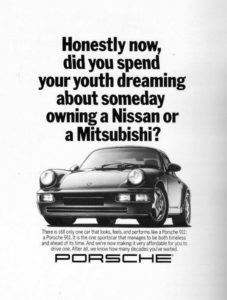The resurgence of marketing professionals
With all of my technology-savviness, I’m still an old-school marketer. The marketing profession for me was never just about the messaging, or the promotional channels, whether it was ATL or BTL. It wasn’t just about the website visits, open rates, CTRs and CPC. It wasn’t really about the technology either – the CRM, the Marketing Automation, the CMS or any other f***ing TLA. I get it – as marketers, we are measured and monitored, and we do have to deliver on those, however, we, as marketing professionals, have lost sight of what is really important, and all of the various factors and fundamentals that make the marketing profession what it really is.
In Corporate-land, marketing professionals have been pushed to work in silos, for way too many decades. The responsibilities of the marketing department have been delegated across the organisation, leaving very little work for the marketers. They’ve been disconnected from Sales, Customer Service, Operations, R&D and Finance. Sales and Marketing have been made to bash heads as if those departments are competitors! Product development has fallen under the “operations” umbrella; Finance teams are working on pricing structures and profitability. Even Customer Service has been separated to become a stand-alone entity! What’s going on??
Breaking the Silos
Jack Welch, the legendary former CEO of GE, was one of the first champions of the “boundaryless-Organisation”. Welch understood over 25 years ago, that the way the world is going, companies will need to work very differently if they wish to survive. He had created the GE Work-Out process, a process designed to encourage cross-function collaboration, better employee engagement, and ultimately – shorter decision cycle. Jack Welch took it upon himself to bring all of these business units together, for the betterment of the company, and ultimately – their customers!
In the past few years, there’s a strong shift in management focus, organising companies around the “customer experience”. Many companies find the transition highly challenging, as it generally requires a complete company restructure, with all of the costs and complications deriving from such activity.
One of the biggest hurdles for organisations, trying to transition from a product/functionality type siloed organisation to a customer-centric one, is office politics. silos encourage behaviours that are beneficial to the occupants of the silo, but are often not in the best interest of the overall business or its customers. Silos help to keep things private, and we all know that in office politics, information is power.
Leveraging a flexible workforce
As long as there are silos in an organisation, the chance of progress is continuously slimming. The reason for such a bold statement is that technology, which is the driver of unprecedented change in the past 2 decades, is changing rapidly. This rapid change in technology is actually shifting the behaviour of consumers in such a way, that most companies today can’t cope with. Accenture Technology Vision 2016 report stated:
Traditional methods cannot keep up with the pace of change in the digital age and forward-thinking businesses are already beginning to learn that their workforce strategy has the potential to be a major competitive advantage.
An innovative workforce strategy has become a must for forward thinking organisations. That’s a strategic approach which takes into account all of the different service engagement options (employment, contractors, outsourcing, off-shoring, etc.) and creating a strategy which allows an agile workforce, provides flexibility to both the company and the team members, increasing efficiency, effectiveness, employee morale and engagement and many other benefits.
This workforce strategy will manifest itself on every level of the organisation. Due to employment flexibility, both employees and employers can have freedoms they have never had before. People will be engaged based on the value they can bring to the organisation, in the shortest amount of time – to keep up with technological progress! So when an organisation need a quick uplift in a certain area, they can use the funds to hire subject matter experts on any level, from C-level down, for any desired period of time.
Building a lasting brand experience
I hear you now asking: “So what does this have to do with marketing? How does breaking the silos, and leveraging technology trends and workforce trends has any effect on marketing?” Let me start by reintroducing what marketing is. Peter Drucker, the father of modern marketing and one of the most prominent thought-leaders in modern business management and leadership, had a few fundamental truths about what marketing is, and where it sits within the business:
“The purpose of a business is to create a customer.”
“Business has only two functions — marketing and innovation. All the rest are costs.”
“The aim of marketing is to know and understand the customer so well the product or service fits him and sells itself.“
If we just focus on the last quote, we will understand how Marketing is an overarching discipline. It doesn’t just focus on promoting products and services. It’s about understanding the customers so well, that they can create, price, and distribute products in such a way that the customer just buys it! There are countless examples of businesses (Apple, Google, Dropbox, Porsche, Buffer, Harley Davidson, Coca-Cola) that have put their marketing efforts on creating such products. They’ve taken the time to understand their customer, understand their needs, desires and motivation, and presented a product that fits those. Porsche had a controversial advert not so long ago. It was controversial because it was confronting, it had mentioned other car brands, and asked this simple question:

It’s a confronting and an unapologetic advertising, but only because Porsche had spent decades building a branded product range, based on their core 911 series. Although Porsche was founded 1947, it wasn’t until 1963 that the 911 model was introduced. The company has always positioned themselves as sports luxury car manufacturers, and focused their efforts on engineering the best performance racing and sports cars, while making the driving experience both exhilarating and comfortable. They understood their target market as being 40-50yo males, with high disposable income, who wants to be associated with the outstanding track record of winning races (the company had won over 30,000 titles in various classes) and enjoying the feeling of driving this outstanding example of engineering. Porsche doesn’t focus their marketing efforts on promoting mediocre, cost-effective cars. Their focus is on creating the best engineered product they can produce, and charging handsomely for it – their profit margins at 14.9% are the highest in the industry, and in their class! As Porsche CEO Matthias Müller once said – Porsche understands itself as a premium car manufacturer with high brand value, which means that creating cheaper models can be negatively perceived by existing customers, who are in fear of losing the exclusivity that they purchased along with a Porsche. (More insights about Porsche Marketing Strategy). Porsche, as depicted in that advert, is the car kids dream about, and adults buy to fulfil their own childhood dreams!
Harley-Davidson is an American icon motorcycle. It’s not the best motorcycle – in fact, for many years the brand had a bad reputation as being of poor mechanical and electrical standards, antiquated technology, and horrible ergonomics. However, that reputation never hurt the brand, as they understood that what motivated their customers to buy, was the badass feeling of riding the Harley, a feeling depicted in many movies (from Easy Rider to Wild Hogs), TV series (too many to count) and even the legendary stunt rider, Evel Knievel used a Harley for many years. Harley-Davidson sponsored Evel for 7 years, a small portion of his career until they withdrew their sponsorship deal following Evel’s conviction of assault. As a side note – this is quite an ironic move – the brand was associated with being a rebel, an outcast of society, yet when their brand ambassador is convicted as one, the company removed their commercial ties with him.
Those products couldn’t have just been built in siloed organisations. “We are committed to motorcycling,” Richard F. Teerlink, Harley’s chairman and former chief executive, said in an interview. “It’s not hardware; it is a lifestyle, an emotional attachment. That’s what we have to keep marketing to.” Harley’s executives are Harley’s owners too, they live the brand, not just work in it. Harley-Davidson has become adept at fostering “customer intimacy” – and even extending the concept to dealers and employees apoteksv.se. The entire company is centred around the customer, and the products are created and celebrated with the customer. One of the most recognised brand attributes of the Harley-Davidson motorcycle is the engine noise. For customers it’s a very important feature of the bike, so make sure this feature stays as a prominent brand element, and not allowing competition to profit from it, Harley has filed papers with the U.S. Patent and Trademark Office to protect its tailpipe rumble. To really understand how a motorcycle manufacturing company is built around the customer, I recommend watching Harley Davidson – Megafactories.
When the entire workforce, every department and every part of the distribution network, are all revolving around the customer, mega brands like Harley-Davidson happen.
A 6yo, $12M tech company with 65 employees and no office!
When Buffer reached a milestone of onboarding their 50th employee, they’ve closed down their office. They didn’t shut the company down – they’ve just worked out that there’s no real advantage to keeping and paying for an office space, rather than allowing their team members, now distributed all over the US and some in London, to work wherever they felt comfortable – be it in a coffee shop, co-working spaces, at home, or even in an RV, whilst traveling around the US!
Buffer’s leadership team has acknowledged the new reality of workforce management and decided to break the mould, get rid of unnecessary expenses (physical office space) and invest in whatever made their team happier and more productive, like choosing their preferred working environment.
Although closing their San Francisco office was a big deal, it wasn’t their only working environment mould-breaking initiative. Since having a distributed, global team (currently – 65 employees), they’ve created a Salary-formula for calculating a fair salary for each of the team members, that will allow them to live comfortably wherever they choose to live. They even went a step further, not only publishing their Salary Calculation formula publically but made those salaries completely transparent – so everyone knows exactly how much each of their peers make and why. When transparency is one of the company’s core values, like we have at Orange Sky, that transparency eliminates topics such as gender equality.
What is really interesting about the 65 employees at Buffer, is that they don’t have anyone with “Marketing” in their title. I don’t know for sure, but I’d like to assume that the founders understand that Marketing and Innovation are the two things that the business does, like Peter Drucker said. If everyone in the company is focused on the customer and what s/he wants, there’s really no need for “marketing”, is there?
[ssm_form id=’3277′]

